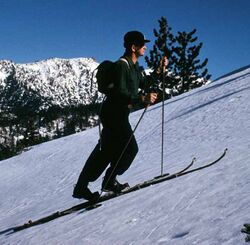Ski skins
Topic: Engineering
 From HandWiki - Reading time: 2 min
From HandWiki - Reading time: 2 min
Climbing skins are strips that attach to the bottom of Nordic, alpine touring or randonnée skis to help while ascending backcountry slopes. They are designed to be removed for skiing downhill. They are typically attached to the skis via a loop on the ski tip, a hook on the tail, and adhesive on the base of the skin. They are called skins because they resemble sealskin, from which the first ski skins were made.[1] They are typically made from nylon or mohair or a combination thereof, and are designed to let the ski slide forward on snow but not backward.[2][3] They are usually narrower than the ski to allow the ski edges to get a grip. Some ski resorts permit skinning.[4][5]
History
Various ethnic groups living in the Arctic regions created a means of transportation across the ice and snow surfaces of their regions, with innovations such as the ski. Attuned to maximizing the use of their materials, one outcome of their innovation was the use of animal skins to gain traction in traveling. As these groups were nomadic, the technology of skis for transportation was integral to continual movement across the region, as well as in maximizing transportation speed while reducing energy expenditure.[6]
Materials
Common materials for manufacturing skins are mohair and nylon. Mohair normally glides better on the forward movement, but provides less grip compared to nylon skins. Mohair skins also tend to pack lighter and easier. Nylon on the other hand has increased durability, especially when used in harsher, icier snow conditions, or on rocks. Depending on regional snow conditions, skiers will tend to prefer one or the other. As a rule of thumb, if snow in the region is softer and more powdery, mohair is preferred. In regions where icy conditions are more likely, nylon is normally the preferred choice. Some companies sell mixed skins using mohair and nylon fibers on the same skin.
See also
- Ski touring
References
- ↑ Richardson, E.C. (1905) Ski-running London : Horace Cox OCLC:1157212706 pg 106
- ↑ Lind, David A.; Sanders, Scott (2013). The Physics of Skiing: Skiing at the Triple Point (2 ed.). Springer Science & Business Media. pp. 270. ISBN 978-1475743456. https://books.google.com/books?id=OpjuBwAAQBAJ&q=climbing+skins&pg=PA161. Retrieved 2016-01-30.
- ↑ "How to Choose, Trim and Attach Ski Climbing Skins". Recreational Equipment, Inc.. https://www.rei.com/learn/expert-advice/ski-skins.html.
- ↑ Cranmore Mountain Resort: Uphill Travel, accessed 18 July 2017
- ↑ Bolton Valley Uphill Policy, accessed 7 February 2020
- ↑ Formenti, Federico (2005). "Human Locomotion on Snow: Determinants of Economy and Speed of Skiing across the Ages". Proceedings: Biological Sciences 272 (1572): 1561–1569. doi:10.1098/rspb.2005.3121. PMID 16048771.
External links
 |
 KSF
KSF


